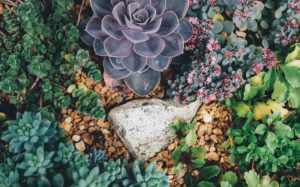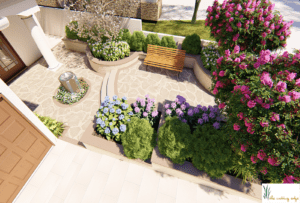Succulents have taken the gardening world by storm, offering a delightful combination of unique beauty and minimal care requirements. These hardy plants are perfect for outdoor gardens, bringing their captivating charm to various climates and landscapes.
In this comprehensive guide, we’ll explore the top 15 low-maintenance succulents that are sure to thrive in your outdoor garden. Not only will we introduce you to these remarkable plants, but we’ll also provide essential tips on how to care for them and create a flourishing succulent paradise in your outdoor space.

1. Sempervivum (Hens and Chicks)
Sempervivum, also known as Hens and Chicks, tops our list for good reason. These succulents form charming rosettes of fleshy leaves, creating a visually appealing ground cover. Resilient and drought-tolerant, they are well-suited for various climates. To ensure their success, water in-ground sempervivums once a week and container plants about three times a week during the summer. As fall approaches, reduce watering to protect against freezes and root rot. This reduction in irrigation is essential because, during the colder months, succulents are susceptible to damage from excess moisture and lower temperatures. Local nurseries or botanical gardens are excellent sources to find these plants, as they can provide advice on the ideal varieties that will thrive in your specific region.
2. Sedum
Sedums offer a vast array of species, each with its own unique allure. These succulents are hardy, heat-resistant, and adaptable to different soil conditions. The ‘Autumn Joy’ variety, known for its pink blooms in late summer, stands out as a popular choice. Sedums are a gardener’s dream, requiring minimal maintenance while providing year-round interest with their vibrant foliage.
These resilient succulents thrive in well-drained soil and are remarkably adaptable to various environmental conditions. Their drought tolerance makes them a preferred choice for gardens in regions with sporadic rainfall. Sedums not only tolerate harsh sunlight but also retain their visual appeal throughout the year, ensuring your garden remains attractive even during the winter months when other plants may be dormant.
3. Agave
Agave plants, boasting their striking, architectural appearance, are a must-have for outdoor gardens. Native to the Americas, they come in various sizes and shapes, offering versatility and resilience. Their drought tolerance and minimal care requirements make them the perfect addition to any landscape. All they need is well-draining soil and occasional watering to thrive. Agaves lend an air of drama and sophistication to your garden, making them an excellent choice for homeowners seeking a low-maintenance yet visually stunning outdoor landscape. Their impressive structural form makes them stand out as focal points in garden designs, and their ability to withstand harsh conditions ensures their longevity in your garden.
4. Echeveria
Echeverias have earned their place as one of the most beloved succulents, thanks to their exquisite rosette-shaped leaves and vibrant colors. These succulents thrive in mild climates, basking in bright, indirect sunlight and well-draining soil. Minimal maintenance is required to keep them happy, making them an ideal choice for gardeners of all levels of experience. Echeverias add a touch of elegance and whimsy to your garden, as their foliage comes in an array of striking colors, including white, grey, green, pink, and red. These charming succulents are perfect for both container gardens and in-ground landscaping, allowing you to incorporate them seamlessly into your outdoor space.
5. Aloe
Aloe vera, known for its medicinal properties, shines as an outdoor succulent in warm, sunny climates. These succulents require infrequent watering and well-draining soil. With their spiky, upright leaves, aloes make a bold statement in any garden, adding both beauty and practicality to your outdoor space. Aloes are celebrated not only for their ornamental value but also for their gel-filled leaves, which contain soothing properties for various skin ailments. Having these versatile succulents in your garden not only enhances its visual appeal but also offers a natural remedy at your fingertips.
6. Crassula
Crassulas, including the ever-popular Jade Plant, are low-maintenance succulents suitable for outdoor gardens in temperate climates. Thriving in well-draining soil and bright, indirect sunlight, they are easy to care for. Once established, they require minimal attention, making them a top choice for gardeners seeking fuss-free beauty. Crassulas are highly adaptable, with some species developing into small trees, while others remain low-growing ground covers. Their intriguing shapes and textures make them captivating additions to any garden, providing visual interest year-round.
7. Graptopetalum
Graptopetalums, native to Mexico and the southwestern United States, come in various colors and shapes, forming captivating rosettes. These succulents are drought-tolerant and thrive as ground cover or in containers. Their delicate appearance adds an elegant touch to any garden, effortlessly blending with the natural landscape. Graptopetalums display a remarkable ability to withstand harsh environmental conditions, making them ideal for low-maintenance gardens. Their compact growth habit and the variety of colors they come in ensure that they can be incorporated into diverse garden designs with ease.
8. Yucca
Yucca plants, with their striking sword-like leaves, are the embodiment of resilience. They can withstand extreme conditions, making them perfect for outdoor gardens. These succulents require minimal care, primarily well-draining soil and occasional watering. Yuccas infuse a touch of southwestern flair into your landscape, making a statement that’s both bold and beautiful. Their architectural form and adaptability to various soil types make them versatile additions to your garden. Whether you’re creating a xeriscape garden or seeking a low-maintenance focal point, yuccas are an excellent choice.
9. Aeonium
Aeoniums, with their exotic rosettes, hail from North Africa’s Canary Islands. While many succulents thrive with minimal moisture, aeoniums prefer a bit more hydration. The darker varieties, such as ‘Zwartkop,’ can even tolerate more sunlight than their lighter counterparts. With their unique appearance, aeoniums are a fantastic addition to container gardens or cut flower arrangements. Aeoniums are known for their captivating rosette formations that come in various colors, from deep purples and blacks to lighter greens and yellows. These succulents offer a distinctive and dramatic flair to your outdoor space, especially when arranged in containers or incorporated into bouquets and arrangements.
10. Haworthia
Haworthias, native to South Africa, are known for their fleshy, pointed leaves arranged in rosettes. They thrive in shaded or dappled sunlight and are well-suited for dry climates. However, overwatering can harm these plants, so it’s essential to exercise restraint in their care. Haworthias display a remarkable array of shapes, sizes, and textures, making them an excellent choice for gardeners looking to diversify their succulent collection. Their compact size and preference for indirect light make them ideal candidates for indoor gardens and terrariums, adding a touch of elegance to your living space.
11. Kalanchoe
Kalanchoes, originating from tropical regions, grace outdoor gardens with their stunning, showy flowers in hues of yellow, red, orange, pink, and white. While they prefer a moist climate, they are not frost-tolerant. Kalanchoes are renowned for their dazzling floral displays, making them a vibrant addition to your garden during the flowering season. These succulents come in a range of sizes and shapes, from compact forms ideal for containers to larger varieties that can become striking focal points in your outdoor landscape. Their colorful blooms attract pollinators, adding an extra layer of life and energy to your garden.
12. Euphorbia
Euphorbias represent a diverse family of succulents, numbering over 1,000 species. They range from cactus-like forms to globe-shaped varieties, some of which make striking focal points in the garden. The well-known poinsettia (Euphorbia pulcherrima) can even grow into shrubs or trees in mild climates. Euphorbias offer an astonishing variety of shapes and sizes, catering to a wide range of garden preferences. From tall, spiky specimens to compact and globular forms, there’s a Euphorbia for every landscape. Many species produce unique and eye-catching flowers, enhancing the visual appeal of your garden.
13. Dasylirion
Dasylirion succulents may resemble palms, but they are indeed succulents. They possess a southwestern aesthetic, featuring strap-like leaves in green, greyish, or blue-green shades, often lined with sharp teeth. Some develop small trunks, which can make them appear less like typical succulents. Dasylirions bring a touch of the desert to your outdoor garden with their striking form and unique foliage. Their adaptability to arid conditions and their ability to thrive with minimal care make them excellent choices for xeriscape gardens and dry climates. These succulents offer a distinctive and exotic look to your landscape, transforming it into a desert oasis.
14. Dudleya
Dudleyas, native to the southwestern United States, exhibit lovely flowers, rosette shapes, and a variety of captivating colors. They are sometimes mistaken for Echeverias, although their growing seasons are opposite. Some Dudleya varieties feature a chalky powder covering their leaves, adding to their unique charm. Dudleyas are prized for their exquisite rosettes and charming blooms that bring a touch of wilderness to your garden. Their range of colors, including greens, reds, purples, and grays, allows for creative and diverse landscaping options. These low-maintenance succulents thrive in various garden settings, from slopes and rock gardens to containers and pergola-covered areas.
15. Graptopetalum
Graptopetalums, originating from Mexico and the southwestern United States, display a kaleidoscope of colors and shapes, forming exquisite rosettes. Notably, these succulents can endure freezing temperatures and recover well after exposure to sub-20-degree conditions. Graptopetalums serve excellently as ground covers, thrive on rocky slopes, and flourish in containers. Graptopetalums are nature’s living mosaics, featuring intricate rosettes that come in a plethora of colors, from vibrant greens to soft purples. Their adaptability to cold temperatures makes them unique among succulents, allowing you to cultivate a garden that remains visually captivating year-round, even in cooler climates. Graptopetalums effortlessly enhance the aesthetics of your outdoor space, providing a dynamic and ever-changing display of color and form.

Planting the Right Succulents
Before diving into succulent gardening, it’s crucial to consider these essential tips:
- Succulents require more water during the summer, but as fall approaches, reduce watering to safeguard against freezes and prevent root rot.
- To ensure your succulents thrive in your specific climate, purchase them from local suppliers, such as nurseries or botanical gardens.
- Enhance your outdoor space by seamlessly integrating succulents into your existing landscape, selecting companion plants that complement their beauty.
With these top 15 low-maintenance succulents and practical gardening tips, you have all the tools you need to create a thriving succulent garden in your outdoor space. Succulents not only enhance the aesthetic appeal of your landscape but also bring a touch of nature’s elegance to your outdoor oasis. Start your succulent garden journey today, and you’ll be rewarded with a resilient and visually captivating outdoor space that requires minimal effort to maintain.
To delve for more information, check outLandscaping Trends for 2023: What’s In and What’s Out.


